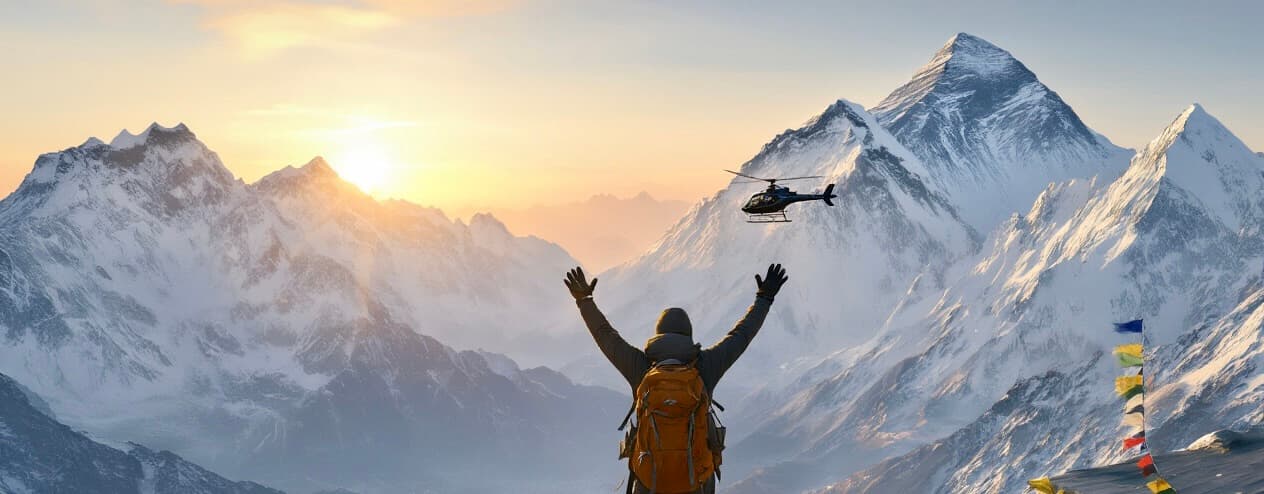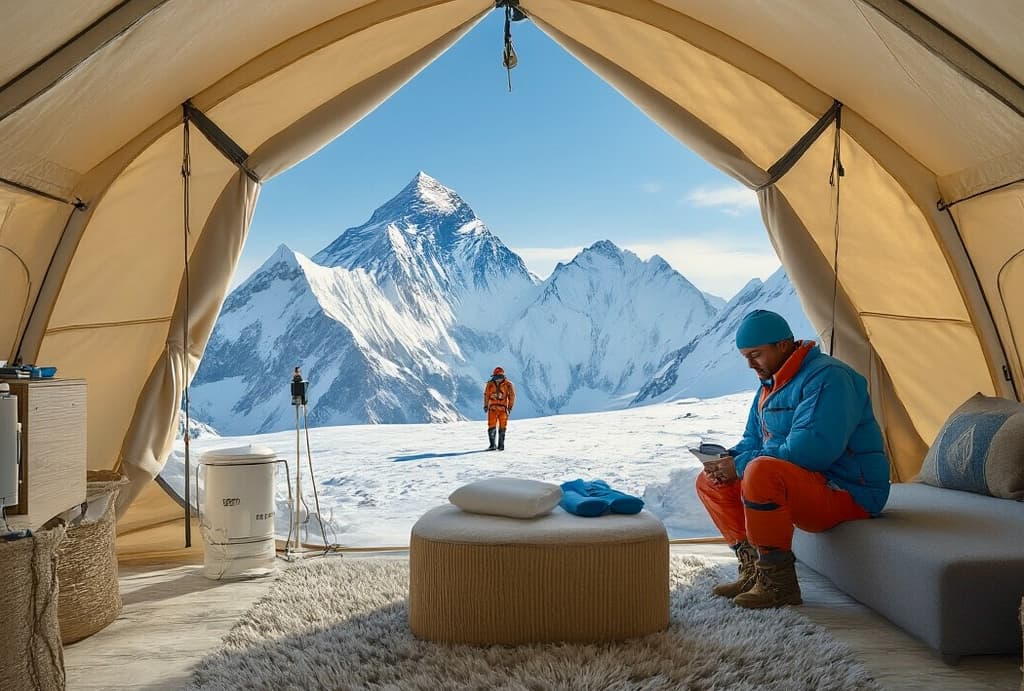Planning an Everest Base Camp trek with a helicopter return? This guide from Luxury Holidays Nepal shows you exactly what to expect. Perfect for adventure seekers who want the full trekking experience going up but prefer a quick return flight. Our detailed maps and altitude charts help you visualize your journey through the Himalayas while avoiding altitude sickness risks.
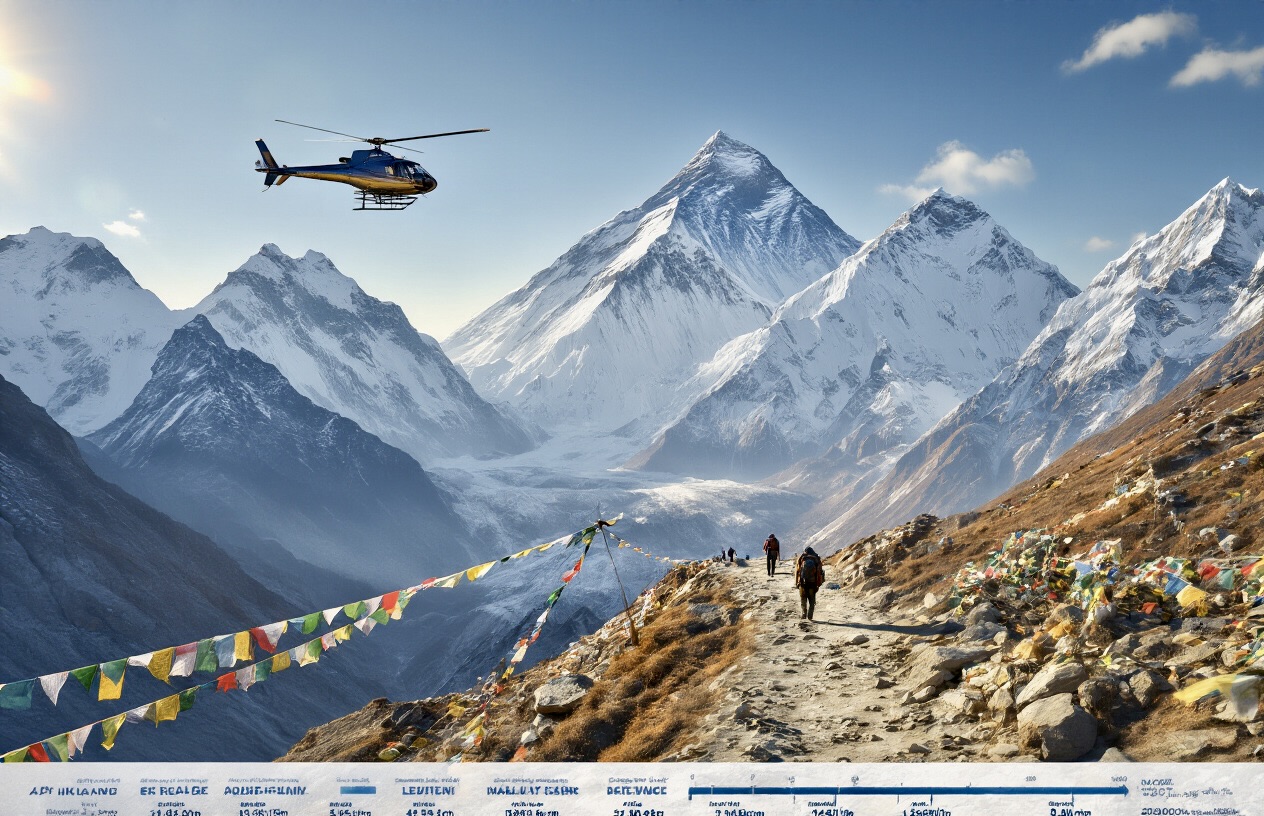
In this guide, we'll cover the complete trek route with elevation profiles, highlight the key stopping points where you'll acclimatize, and explain how the helicopter return option saves you 3-4 days of hiking. We've helped hundreds of trekkers experience this perfect blend of adventure and convenience.
Trek Overview and Highlights
The 10-Day Itinerary: From Lukla to Everest Base Camp
Our Everest Base Camp Trek with Helicopter Return is designed as a moderate 9-10 day adventure that begins with a flight from Kathmandu to Lukla. The trek follows a carefully planned itinerary with ample rest days to help trekkers acclimatize and avoid altitude sickness. Each day involves approximately 5-6 hours of walking, making it suitable for anyone with reasonable fitness levels and determination.
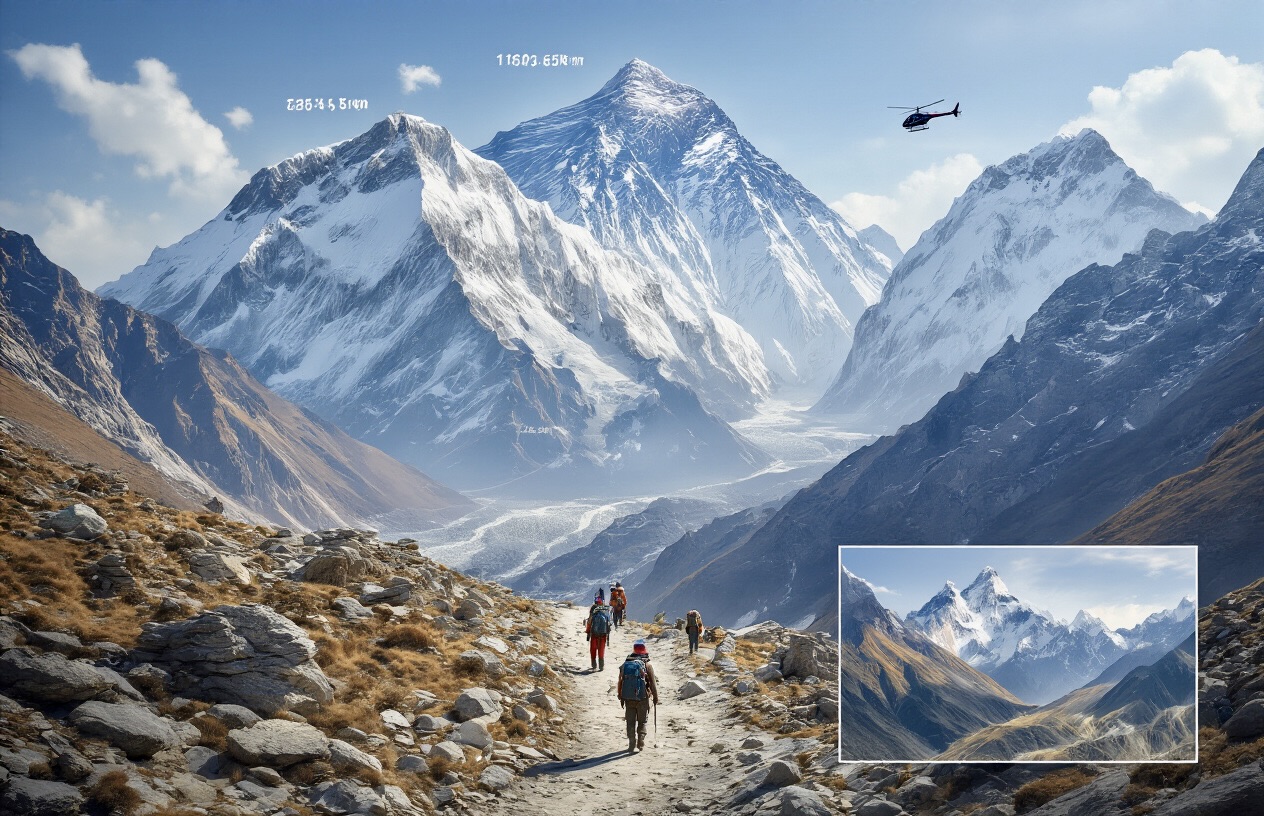
The journey takes you through stunning Himalayan landscapes, charming Sherpa villages, and gradually increasing elevations as we make our way toward the base of the world's tallest mountain.
Helicopter Return Experience: Aerial Views of the Himalayas
One of the most exciting aspects of our trek is the helicopter return journey. After reaching Everest Base Camp and hiking up to Kala Patthar, we arrange a shared helicopter flight from Gorakshep to Lukla. This thrilling aerial experience offers spectacular views of the Himalayan range that few get to witness.
The helicopter ride not only provides incredible photo opportunities but also significantly reduces the return journey time, allowing you to enjoy the majesty of the mountains without the additional days of trekking back down.
Peak Elevation Points: Everest Base Camp (5,364m) and Kalapatthar (5,545m)
The trek reaches its highest points at Everest Base Camp (5,364m) and Kala Patthar (5,545m). At Kala Patthar, we schedule an early morning hike to witness the breathtaking sunrise over Mt. Everest and surrounding peaks. This vantage point offers the most iconic views of Everest and is often considered the highlight of the entire trek.
After taking time to absorb the magnificent scenery at these peak elevations, we make our way back to Gorakshep before boarding our helicopter flight.
Key Attractions: Namche Bazaar, Tengboche Monastery, Sherpa Culture
Throughout our journey, we'll encounter numerous cultural and natural attractions. While the reference materials don't specifically detail Namche Bazaar and Tengboche Monastery, these are key stopping points along the classic Everest Base Camp route.
Our trek also provides ample opportunities to experience authentic Sherpa culture, with visits to traditional villages and interactions with local communities. The journey isn't just about reaching Everest Base Camp but also about immersing yourself in the rich cultural heritage of the Khumbu region.
We ensure our itinerary balances challenging trekking days with cultural experiences, creating a comprehensive adventure that showcases both the natural beauty and cultural significance of this iconic region.
Essential Pre-Trek Information
Best Seasons for Trekking: Spring (March-May) and Autumn (September-November)
We recommend planning your Everest Base Camp trek during the pre-monsoon (March-May) or post-monsoon (September-November) seasons for the best experience. These periods offer clearer skies, safer trail conditions, and optimal visibility of the majestic Himalayan range.
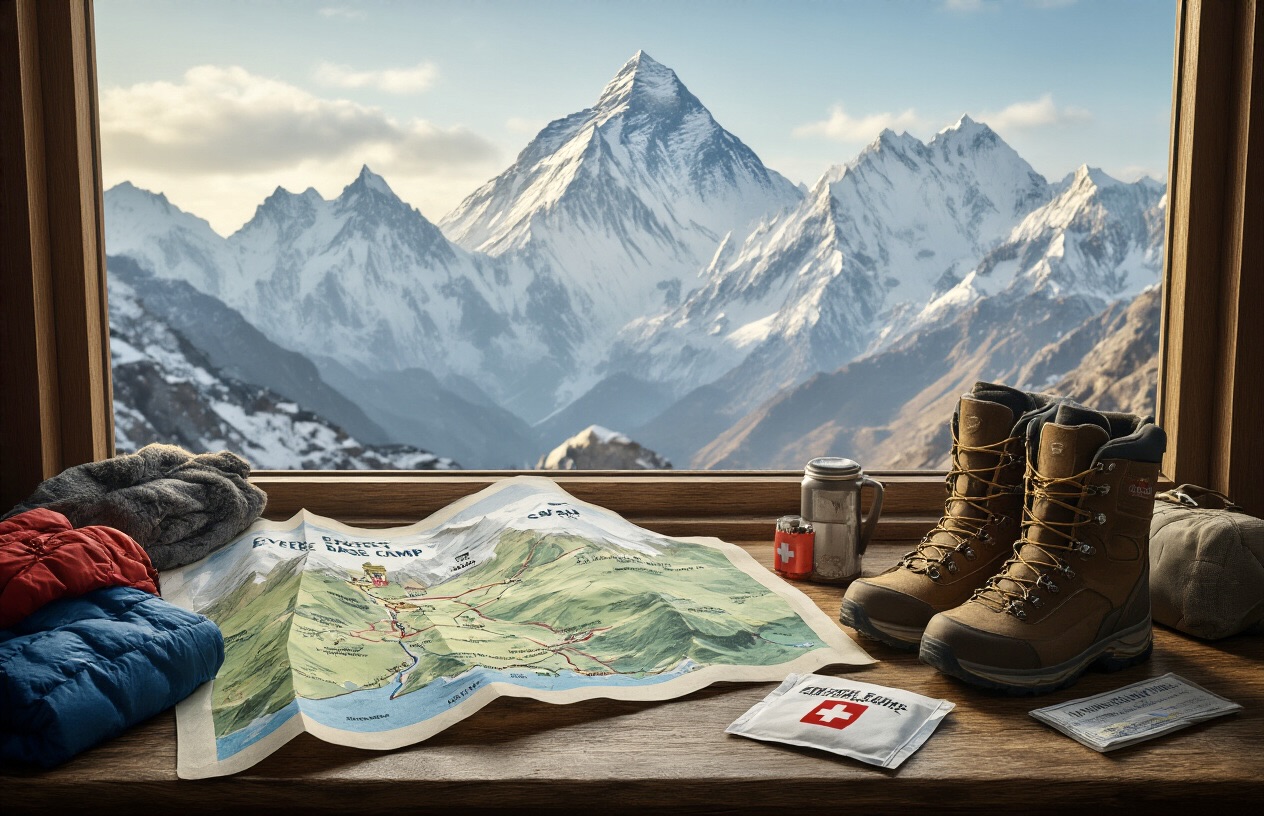
Spring (March-May) brings the trail to life with blooming rhododendrons and comfortable temperatures. The landscape becomes vibrant and colorful, creating perfect opportunities for photography. The slightly warmer temperatures make this season particularly pleasant for trekkers who prefer milder weather conditions.
Autumn (September-November) offers crisp air and the clearest mountain views of the year. This is the most popular trekking season overall, as the post-monsoon clarity allows for spectacular panoramas of Everest and surrounding peaks.
We strongly advise against trekking during the monsoon season (June-August) due to heavy rainfall, slippery trails, and frequent flight cancellations to Lukla. Similarly, winter (December-February) presents challenges with snow-blocked passes and sub-zero temperatures, though the trails are considerably quieter.
For those seeking fewer crowds, consider the shoulder seasons in late February or early December, but be prepared for variable conditions.
The timing of your trek significantly impacts visibility, flight reliability, accommodation availability, and health risks. We recommend booking early during peak seasons to secure lodge reservations and guide availability.
Nepal Visa Requirements and Application Process
A valid visa is required for entry into Nepal before beginning your Everest Base Camp trek. We advise obtaining your visa either in advance through a Nepalese embassy or consulate in your home country or upon arrival at Tribhuvan International Airport in Kathmandu.
For trekking purposes, most visitors apply for a tourist visa, which comes in three durations:
- 15-day visa
- 30-day visa
- 90-day visa
The visa application process is straightforward. You'll need:
- A valid passport with at least six months' validity remaining
- Completed visa application form
- Passport-sized photographs
- Visa fee payment in the specified currency
When applying for your visa on arrival in Kathmandu, we recommend having exact change ready in US dollars to expedite the process. Electronic visa kiosks are available at the airport to streamline the application procedure.
Travel Insurance Coverage Requirements for High-Altitude Trekking
We cannot overemphasize the importance of comprehensive travel insurance for your Everest Base Camp trek. Standard travel insurance typically does not cover high-altitude activities, so we strongly recommend purchasing specialized coverage.
Your insurance policy must include:
- Medical evacuation coverage up to at least 6,000 meters
- Helicopter rescue services
- Treatment for altitude-related illnesses
- Coverage for trekking activities above 5,000 meters
- Trip cancellation protection
- Coverage for lost or damaged equipment
Before purchasing your policy, we advise carefully checking the altitude limitations and specific exclusions. Many standard policies exclude activities above 3,000 meters, which would not suffice for Everest Base Camp at 5,364 meters.
Several insurance providers specialize in high-altitude trekking coverage. We recommend obtaining quotes from multiple companies and thoroughly reviewing the policy details to ensure adequate protection.
Flight Details: Kathmandu to Lukla Options and Considerations
The journey to Everest Base Camp typically begins with a flight from Kathmandu to Lukla, which serves as the gateway to the Everest region. This 35-minute flight offers spectacular mountain views but comes with several important considerations.
Flight reliability: Lukla flights are highly weather-dependent and can be canceled or delayed due to poor visibility, wind, or other adverse conditions. We recommend building buffer days into your itinerary at both the beginning and end of your trek.
Booking options: We suggest booking your flights through a reputable trekking agency well in advance, especially during peak seasons when availability becomes limited. Most flights operate in the early morning when weather conditions are typically more favorable.
Alternative routes: In case of extended flight cancellations, alternative options include:
- Helicopter services (considerably more expensive but more reliable in poor weather)
- Flights to Ramechhap (during peak season when Kathmandu flights are overbooked)
Luggage restrictions: Strict weight limitations apply for Lukla flights, typically 10-15kg for checked baggage and 5kg for hand luggage. We advise packing carefully and considering leaving non-essential items in storage at your Kathmandu hotel.
Physical Preparation and Health Considerations
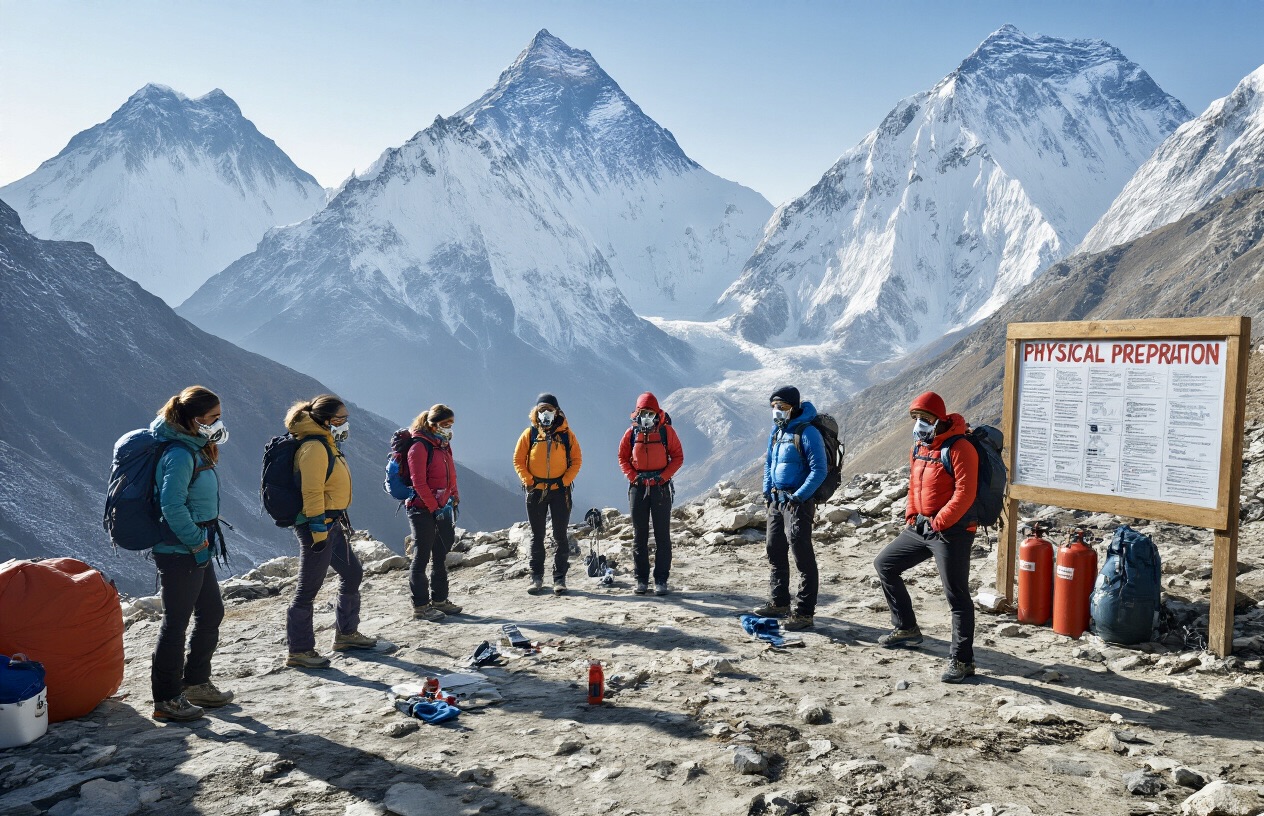
Fitness Requirements and Training Recommendations
We highly recommend preparing physically for the Everest Base Camp trek, as it involves long days of hiking at high altitudes. While altitude sickness can affect anyone regardless of age, sex, or physical fitness, being in good shape will make your trek more enjoyable.
For optimal preparation:
- Focus on cardiovascular exercise like hiking, walking, cycling, or swimming
- Build endurance with longer training sessions
- Include uphill training to prepare for the ascents
- Start training at least 2-3 months before your trek
- Gradually increase the intensity and duration of workouts
Remember, even very fit individuals can still experience altitude sickness, so fitness alone isn't a guarantee against altitude-related issues.
Altitude Sickness: Symptoms, Prevention, and Management
Altitude sickness typically strikes from around 3,000m (9,840 ft) above sea level, which means most trekkers will experience some symptoms during the Everest Base Camp trek. On the day you trek up to Namche Bazaar (3,440m), approximately 75% of climbers will experience at least mild altitude sickness.
Common symptoms include:
- Shortness of breath or rapid breathing
- Fatigue and weakness
- Nausea and sometimes vomiting
- Dizziness and headaches
- Loss of appetite
- Disturbed sleep patterns (insomnia, vivid dreams)
At high altitudes, the percentage of oxygen in the air remains the same (about 21%), but there are fewer oxygen molecules per breath. At 3,600m (12,000 ft), there are roughly 40% fewer oxygen molecules than at sea level, which is why even simple tasks can leave you breathless.
Prevention strategies:
- Drink plenty of water to increase blood oxygen levels
- Eat nutritious meals even if you don't feel hungry
- Consider altitude medications like Diamox (consult your doctor before your trip)
- Follow the "climb high, sleep low" principle during acclimatization days
If symptoms worsen and develop into Acute Mountain Sickness (AMS), descent is the only reliable treatment. AMS can be fatal if ignored, so always listen to your trek guide's advice about turning back if necessary.
Acclimatization Process and Schedule
Proper acclimatization is crucial for a successful Everest Base Camp trek. We implement three key strategies to help your body adjust safely:
- Allowing sufficient days for the ascent: We recommend at least 7 days from Lukla to Base Camp to give your body time to adapt to increasing altitudes.
- Including dedicated acclimatization days: Most trekkers take an acclimatization day in Namche Bazaar (3,440m) after the significant elevation gain from Phakding (2,610m). For longer routes like the Three Passes trek, we recommend at least two acclimatization days, including one in Chhukung (4,730m).
- Practicing "climb high, sleep low": On acclimatization days, we take day hikes to higher elevations before returning to sleep at a lower altitude. In Namche Bazaar, a popular day hike is to Hotel Everest View (3,962m), which helps your body adjust while also offering spectacular mountain views.
If you're struggling with altitude sickness, we always recommend adding another rest day rather than pushing on. This flexibility increases your chances of completing the trek successfully.
Essential Medications and Health Precautions
We advise bringing the following medications and taking these health precautions:
- Altitude medication: Consult your doctor before your trip about Diamox (acetazolamide), which helps prevent and reduce altitude sickness symptoms.
- Personal medications: Visit your doctor before traveling to Nepal to discuss your planned trip and receive personalized advice based on your medical history.
- Evacuation insurance: Ensure you have comprehensive travel insurance that covers helicopter evacuations, which are extremely expensive but may be necessary in severe cases of AMS.
- Hydration and nutrition: Carry a water bottle and drink at least 1-1.5 extra liters daily at altitude. Eat well at mealtimes even if your appetite is reduced.
- Communication: Always inform your trek guide and trekking partners if you're feeling unwell so they can monitor your condition.
By following these precautions and acclimatizing properly, most trekkers can complete the Everest Base Camp trek safely and enjoy this magnificent adventure to the fullest.
Accommodation and Comfort
Teahouse Standards and Facilities Along the Route
On the Everest Base Camp trek, Nepal offers unique accommodation options with tea houses available at most stops along the route. These lodgings provide private rooms, unlike European mountain lodges, where dormitory-style sleeping is common. The comfort levels are highest in the Everest, Annapurna, and Langtang regions.
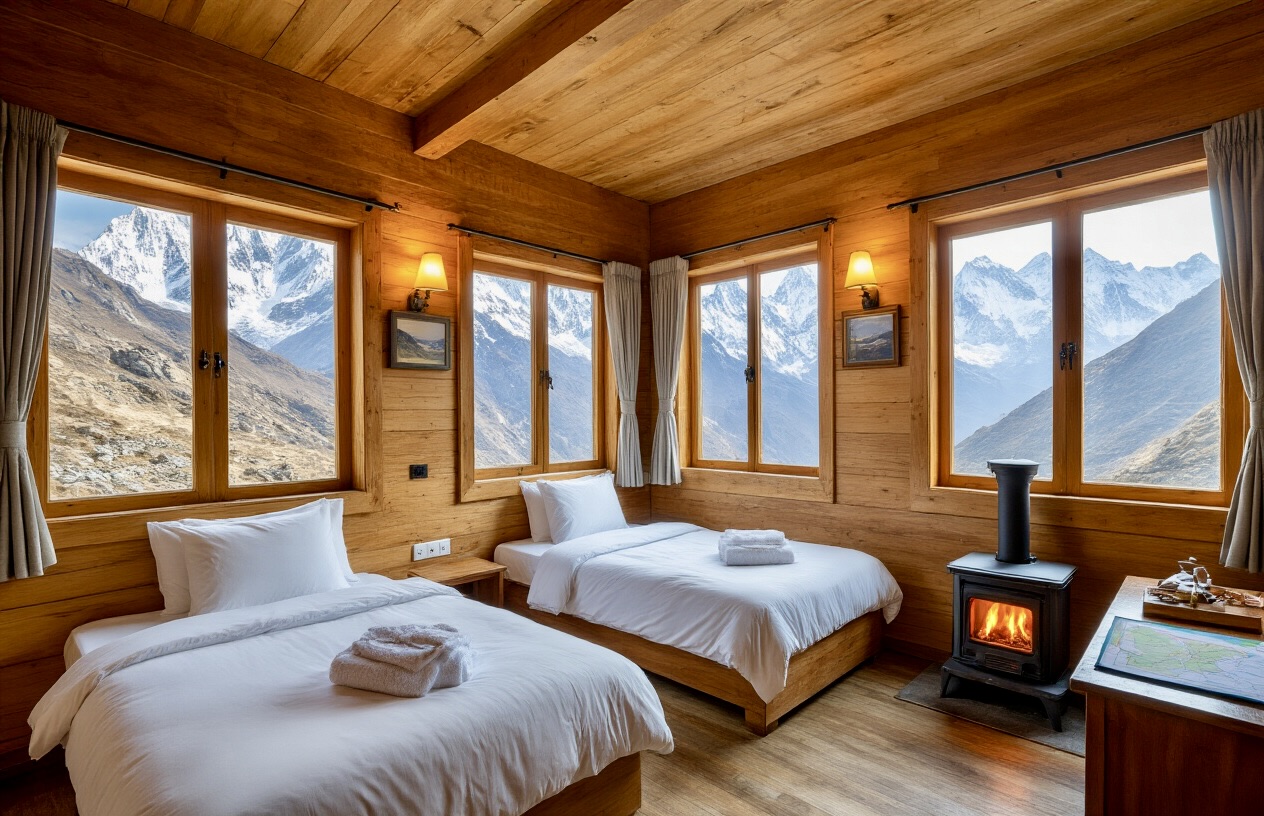
The quality of tea houses varies considerably along the route. Accommodations are quite comfortable up to Pheriche, especially with options like Everest Summit Lodges and Mountain Lodges of Nepal. However, conditions become more basic at higher elevations, particularly at Lobuche and Gorak Shep.
When selecting a tea house, we recommend looking for rooms that:
- Have an attached bathroom when possible
- They are located away from the toilets and dining areas
- They are positioned at the end of hallways to minimize noise
- They are on the top floor for better views and quieter surroundings
Most tea houses earn their primary income from food rather than lodging. You can typically negotiate rates during less busy periods, though it's important to be respectful and not bargain too aggressively.
Luxury Lodges on the Everest – Options and Upgrades
For trekkers who wish to combine the adventure of the Everest region with the comfort of premium accommodation, there are several high-end lodge options available along the lower stretches of the trail. These lodges offer a much higher standard of comfort, service, and amenities compared to standard tea houses.
Everest Summit Lodges – Operating in select locations up to Pheriche, these lodges provide elegant rooms, warm interiors, and exceptional hospitality. They feature upgraded bedding, heated dining rooms, hot showers, and a relaxing atmosphere after a long day’s trek.
Mountain Lodges of Nepal (MLN) – Known for their refined service and thoughtfully designed lodges, MLN properties blend local charm with modern amenities, ensuring trekkers enjoy a premium stay while immersed in the Himalayan landscape.
Rivendell Lodge, Deboche – A long-standing favorite that now features a newly built wing meeting Western standards. Upgraded rooms cost around $50 per night and include en-suite hot showers, internet access, device charging facilities, quality bed linens, and even electric blankets for added warmth.
Highland Sherpa Resort, Lower Pangboche – A comfortable and well-located lodge offering rooms with attached bathrooms at more moderate rates than the luxury operators, making it a great middle-ground option for comfort-conscious trekkers.
By choosing these luxury lodges on the Everest trail, trekkers can enjoy the rugged beauty of the Khumbu region without compromising on comfort, ensuring a rejuvenating rest each night in one of the world’s most spectacular trekking destinations.
Kathmandu Hotel Options: 3-Star to 5-Star Choices
Before and after your trek, Kathmandu offers a wide range of accommodation options:
3-Star Options: Comfortable, affordable lodging with basic amenities.
4-Star Options: Hotels like Lukla Numbur Hotel, which has good airline connections (important if your flight gets canceled due to weather).
5-Star Options: For premium comfort before or after your challenging trek, Kathmandu offers several international standard luxury hotels.
When selecting your Kathmandu accommodation, we recommend prioritizing hotels with good airline connections, especially for your post-trek stay, as this can be invaluable if you experience flight cancellations due to weather.
Electricity Availability and Device Charging Options
Power access varies significantly along the trek route:
- Lower Elevations: In places like Lukla, Phakding, Namche, and Kyangjuma, charging is often provided free of charge.
- Mid-Range Elevations: At Pangboche and similar altitudes, you can sometimes negotiate free charging, but it becomes increasingly costly as you ascend.
- Higher Elevations: Expect to pay for charging services, with costs increasing with altitude. For reference, charging a phone at Dzongla costs around NPR 300, with power banks costing more.
- Internet Access: Most lodges provide Wi-Fi access, though it typically costs around NPR 500 per day. A more economical option is purchasing an Everest Link internet package in Lukla or Namche (NPR 1,999 for 10GB or NPR 2,999 for 20GB, valid for 30 days).
For those frequently trekking in remote areas, investing in a solar charging system might be worthwhile. Some trekkers report success with 3-panel solar systems attached to their backpacks.
Trek Logistics and Practical Matters
Transportation Details: Flights, Helicopters, and Ground Transfers
When planning your Everest Base Camp trek with a helicopter return, understanding transportation logistics is crucial. For flights to Lukla, weight limits are strictly enforced - 10kg/22lbs in your duffel bag and 5kg/11lbs in your backpack. If you're taking a helicopter, you can bring up to 15kg/33lbs in your duffel bag, but you'll be weighed with your backpack as well. The maximum weight capacity on helicopters is 500kg, so groups are typically split accordingly.
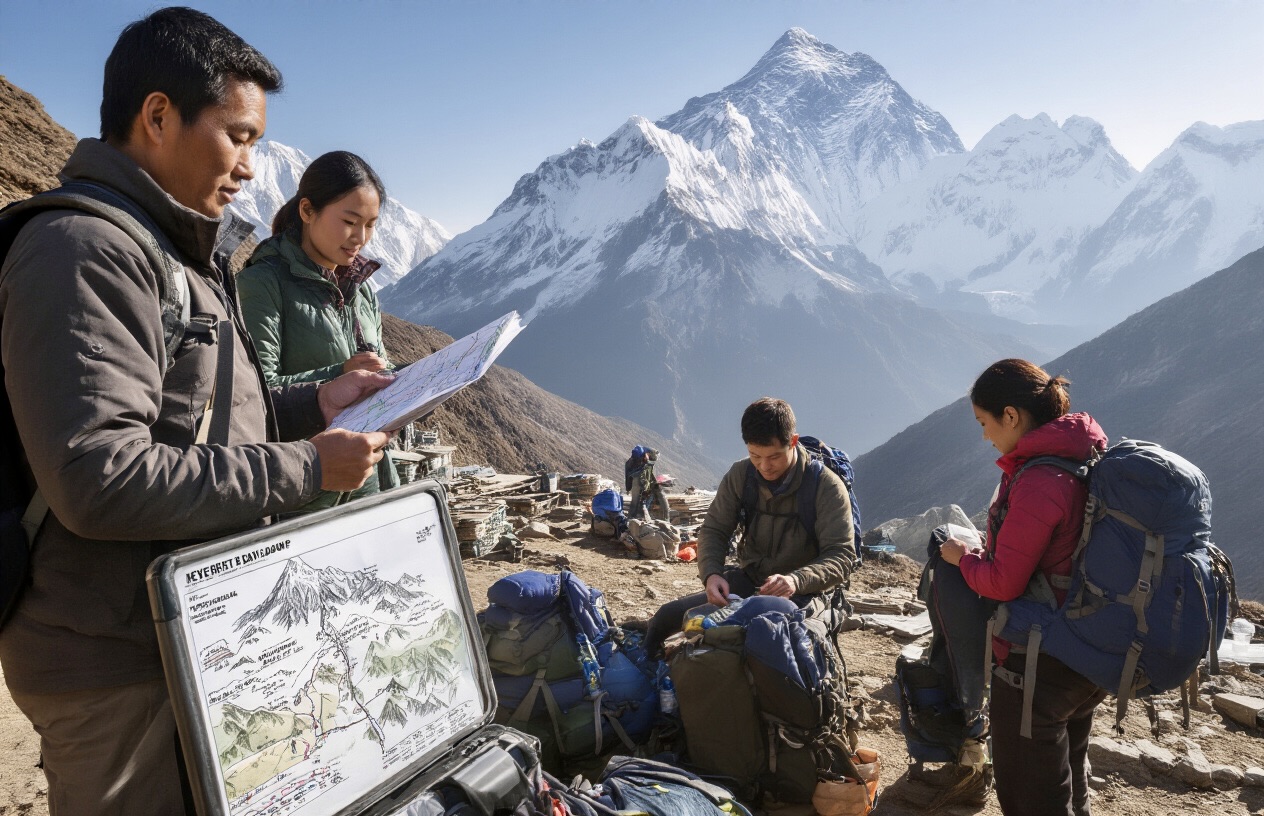
We primarily use ground transfers to reach the starting point of the trek, followed by domestic flights from Kathmandu to Lukla (or sometimes Ramechhap to Lukla). For your return journey, the helicopter option provides spectacular views and saves you valuable trekking days.
Packing Essentials for Everest Base Camp Trek
- Trekking Equipment
- Duffel bag (100 liter minimum)
- Backpack (35 liter)
- A rain cover for a backpack
- Trekking poles (available for rent in Kathmandu)
- Sleeping bag (rated to 0°F, available for rent)
- Sleeping bag liner (optional)
- Hydration bladder (2 liter minimum)
- Water bottles (two 1-liter bottles)
Clothing
- Base layers: Merino wool (1 top, 1 bottom)
- Middle layers: Down vest and fleece layer
- Outer layers: Proper down jacket, Gore-Tex rain gear (top and bottom)
- Trekking boots with proper ankle support
- Lodge shoes/trail runners
- Socks (6 pairs plus a couple of thicker pairs)
- Warm hat/beanie
- Sun hat or sports cap
- Gloves (inner liner gloves and waterproof outer gloves)
- Lodge clothes (comfortable change of clothes)
- Buff/neck gaiter (we provide one at the briefing)
Seasonal Considerations
We recommend different gear depending on when you trek:
- February, March, November, December: Warmer layers, heavier down jacket, 0°F sleeping bag
- May, September: Lighter options, potentially a 15°F sleeping bag
- December: Extra warm clothing, -20°F sleeping bag, warmer gloves
Communication Options: Wi-Fi, Mobile Networks, and Satellite Phones
Communication facilities along the Everest Base Camp trek have improved in recent years. Wi-Fi is available at most teahouses in larger settlements like Namche Bazaar and Dingboche, though connectivity weakens as you ascend higher. The service typically requires payment and can be slow or intermittent.
Mobile networks function reasonably well in the lower regions of the trek. We recommend purchasing a local SIM card in Kathmandu before starting your journey. Nepal Telecom and Ncell are the primary service providers with coverage in the Everest region.
For guaranteed communication in remote areas, satellite phones are the most reliable option. Our guides carry satellite phones for emergency communications, ensuring we can always contact support services if needed.
Currency, ATMs, and Money Management During the Trek
We recommend bringing a minimum of $500 in cash for your trek. ATMs are available in Namche Bazaar, but they frequently run out of cash or experience technical issues. Beyond Namche, there are no reliable banking facilities.
Most teahouses and shops along the trail accept Nepalese Rupees only, so exchanging currency in Kathmandu before departing is advisable. Higher-end establishments in Namche may accept credit cards, but always carry enough cash to cover your expenses.
Remember that prices increase with altitude due to the cost of transporting goods. Additional expenses to plan for include:
- Hot showers (available for a fee at most teahouses)
- Wi-Fi access
- Battery charging
- Snacks and additional meals
- Souvenirs
For security, we recommend distributing your cash in different locations within your luggage and using money belts when carrying larger amounts.
Cultural and Environmental Aspects
Sherpa Culture and Buddhist Traditions
The Sherpa people are one of the Tibetan ethnic groups native to the mountainous regions of Nepal, particularly in the Solukhumbu district of the Everest region. We can trace their origins back to Tibet, with migration to Nepal occurring around the 15th or 16th centuries. The name "Sherpa" derives from Tibetan words "shar" (east) and "pa" (people), meaning "people of the east."
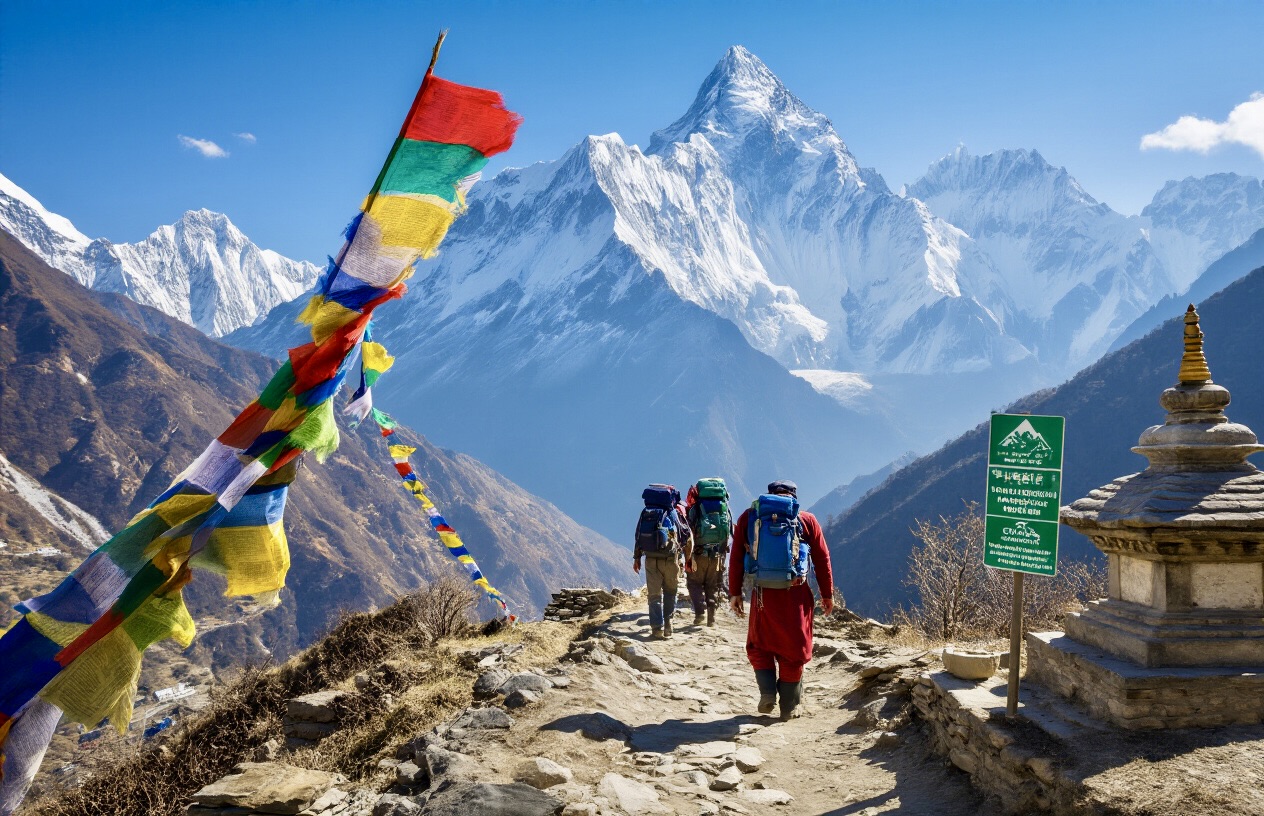
Sherpas predominantly practice Buddhism (98.9%), specifically following the Nyingma school of Tibetan Buddhism. This ancient Buddhist sect was founded by Padmasambhava (Guru Rinpoche) during the 8th century. Their religious practices blend mysticism with local deities shared by the pre-Buddhist Bön religion, which contains shamanic elements.
In Sherpa communities, religious affairs are presided over by lamas who can be either celibate monks or married householders. Additionally, shamans (lhawa) and soothsayers (mindung) help community members deal with the supernatural world. The monastery, or gompa, serves as the central prayer hall for villages, with approximately two dozen monasteries scattered throughout the Solukhumbu region.
Sherpas hold mountains as sacred entities. They call Mount Everest "Chomolungma," meaning "Mother of the World," and worship it as a deity. Other peaks like Mount Makalu are respected as the deity Shankar (Shiva). Each clan reveres certain mountain peaks and their protective deities.
Proper Etiquette at Monasteries and Villages
When visiting Sherpa communities, we must understand their social hierarchies and customs. In all social gatherings, men are seated by order of status, with those of higher status sitting by the fireplace and those of lesser status closer to the door. Women typically sit in the center without specific ordering.
At monasteries, visitors should show proper respect by:
- Removing shoes before entering prayer halls
- Speaking quietly and not disturbing prayer sessions
- Asking permission before taking photographs
- Walking clockwise around religious monuments (stupas and mani walls)
- Refraining from touching religious artifacts without permission
In Sherpa villages, proper etiquette includes showing the utmost respect to elders and offering warm hospitality to guests. The Sherpa community emphasizes social gatherings and building bonds with everyone in the community.
Environmental Responsibility and Sustainable Trekking Practices
Mount Everest is located within the Sagarmatha National Park, which is a sacred landscape for local Sherpas. They consider this region to be the dwelling of supernatural beings and value the sanctity of all living things, avoiding killing any creatures.
We must be aware that tourism has sometimes disrupted these sacred lands. For example, cutting trees for firewood directly contradicts Sherpas' spiritual law of the land. As responsible trekkers, we should:
- Use established accommodation that employs sustainable energy sources
- Carry all non-biodegradable waste back with us
- Use water purification methods rather than buying plastic bottles
- Stay on marked trails to minimize environmental impact
- Respect wildlife and plant life throughout the journey
- Support local conservation initiatives
The park is governed by authorities who have created buffer-zone user groups to include Sherpa voices in management decisions, though these groups don't have official status in government policy.
Local Festivals and Cultural Experiences
The Sherpa culture is heavily influenced by Tibetan traditions, as reflected in their festivals and celebrations. They follow the Tibetan lunar calendar for important ceremonies.
Key festivals include:
- Gyalpo Losar: The Sherpa New Year celebration, typically falling in February, involves family gatherings, special foods, and religious ceremonies
- Mani Rimdu: A 19-day festival celebrated at Tengboche Monastery, featuring colorful masked dances, religious rituals, and the symbolic destruction of evil forces
These festivals offer trekkers an opportunity to witness authentic Sherpa culture. The monasteries like Tengboche, Thame, and others regularly host ceremonies that visitors may attend with proper respect.
The traditional Sherpa dress reflects their Tibetan heritage. Men wear long-sleeved robes called chuba, tied at the waist with a cloth sash (kara). Women traditionally wear long-sleeved floor-length dresses called tongkok, with colorful striped aprons (pangden for married women).
Sherpa cuisine also forms part of the cultural experience, with dishes like thukpa (noodle soup) and thenduk (stew) providing nourishing meals designed to keep the body warm in cold mountain temperatures.
Trek Cost and Services
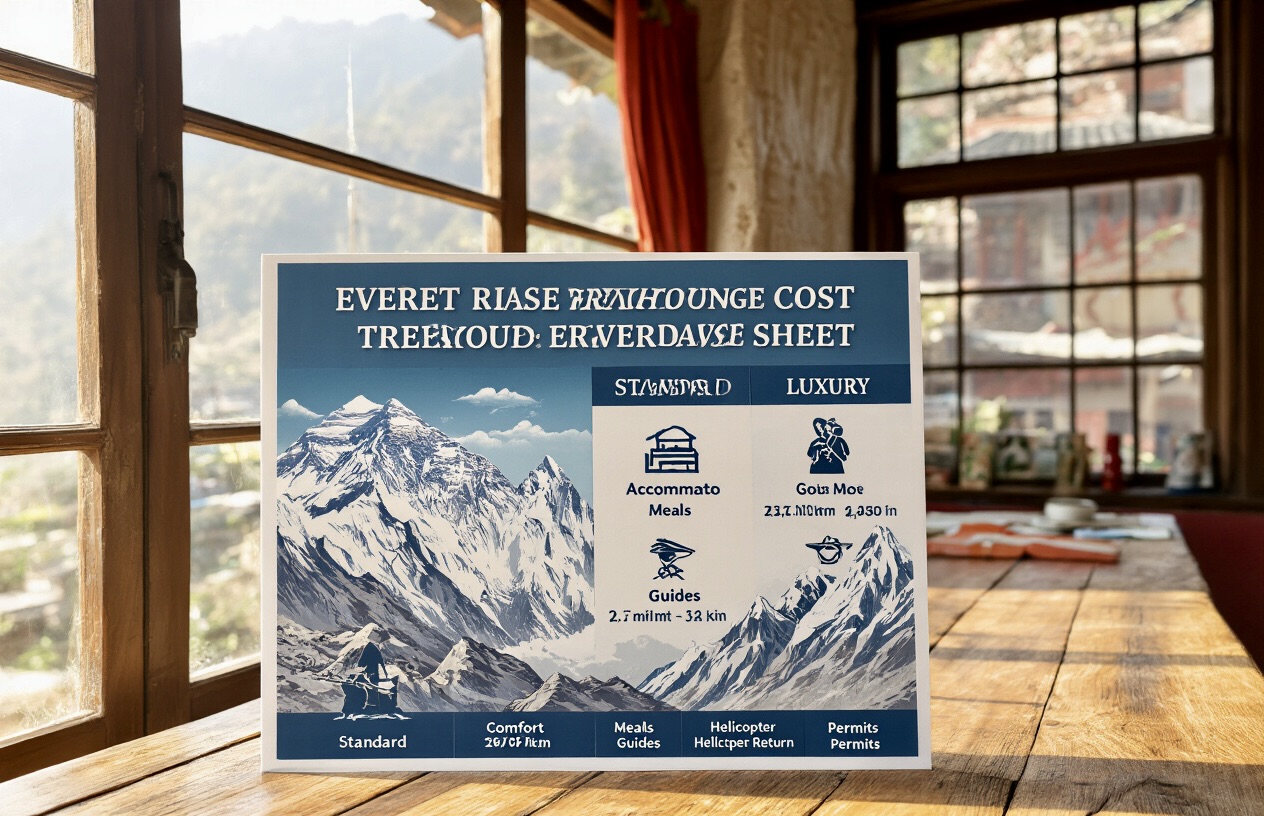
Standard Package Inclusions and Exclusions
Our luxury Everest Base Camp trek packages typically include comprehensive services to ensure your comfort and safety.
What's Included:
- Accommodation in 5-star hotels in Kathmandu (Marriott, Dwarika's, or Hyatt Regency)
- Domestic flights between Kathmandu and Lukla
- Luxury lodge accommodations during the trek (where available)
- All meals (breakfast, lunch, and dinner)
- Tea, coffee, snacks, and filtered drinking water
- All necessary permits (Sagarmatha National Park entry, Khumbu Rural Municipality fee)
- Professional English-speaking guides trained in altitude sickness management
- Porters to carry your main bags (typically one porter per trekker)
- Emergency support including medical backup and oxygen cylinders
- Private ground transportation and airport transfers
- Welcome and farewell dinners in Kathmandu
What's Not Included:
- International flights to and from Nepal
- Nepal visa fees (available upon arrival)
- Personal travel insurance (must include helicopter evacuation and trekking coverage)
- Tips for guides and porters
- Personal expenses, shopping, snacks, or alcoholic beverages
- Equipment such as sleeping bags or down jackets (unless specified)
Price Range: Budget to Luxury Options ($1,350-$4,500)
We offer several pricing tiers to accommodate different preferences and budgets:
Standard Luxury Trek: $2,500-$4,500 per person
- Five-star accommodations in Kathmandu
- Premium lodges during the trek
- All meals and guided services
- Regular domestic flights
Luxurious All-Inclusive Package: $4,000-$6,500 per person
- Everything in the standard luxury package
- Personalized guide service
- Helicopter return option
- Additional luxury amenities
- Possible spa or wellness services
Customized Luxury Experience: $6,000+
- Fully private or customized itineraries
- VIP amenities
- Private chefs
- Helicopter trips for scenic viewing
Tipping Guidelines for Guides and Porters
Tipping is an important part of Nepalese trekking culture and should be considered when budgeting for your trip. Our recommended tipping guidelines:
- Guides: $10-15 per day per guide
- Porters: $5-10 per day per porter
Tipping amounts can be adjusted based on the level of service and your satisfaction. We recommend presenting tips at the end of your trek, perhaps during a farewell gathering with your team.
Additional Services and Customization Options
We pride ourselves on offering customizable experiences to make your journey truly special:
- Helicopter Return Option
- Avoid the 3-4 day descent back from Everest Base Camp
- Costs between $1,000-$2,500, depending on whether you book privately or share
- Provides spectacular aerial views of Mount Everest, Lhotse, Ama Dablam, and the Khumbu Valley
- Pickup typically from Gorak Shep or Kala Patthar
- Flight time of approximately 30-60 minutes
Other Customization Options:
- Detours to special locations like Thame Monastery or Ama Dablam Base Camp
- Cultural tours of Patan or Bhaktapur
- Adjusted trekking pace based on your fitness and preferences
- Post-trek extensions to Pokhara or other destinations
- Special dining experiences
- Spa services in Kathmandu before or after your trek
We're committed to creating the perfect balance of adventure and comfort for your Everest journey, with customizations available to meet your specific needs and desires.
Safety and Security Measures
At Luxury Holidays Nepal, we prioritize your safety throughout the Everest Base Camp trek with a helicopter return. Our comprehensive safety protocols ensure you can focus on the breathtaking landscapes while we handle the security details.
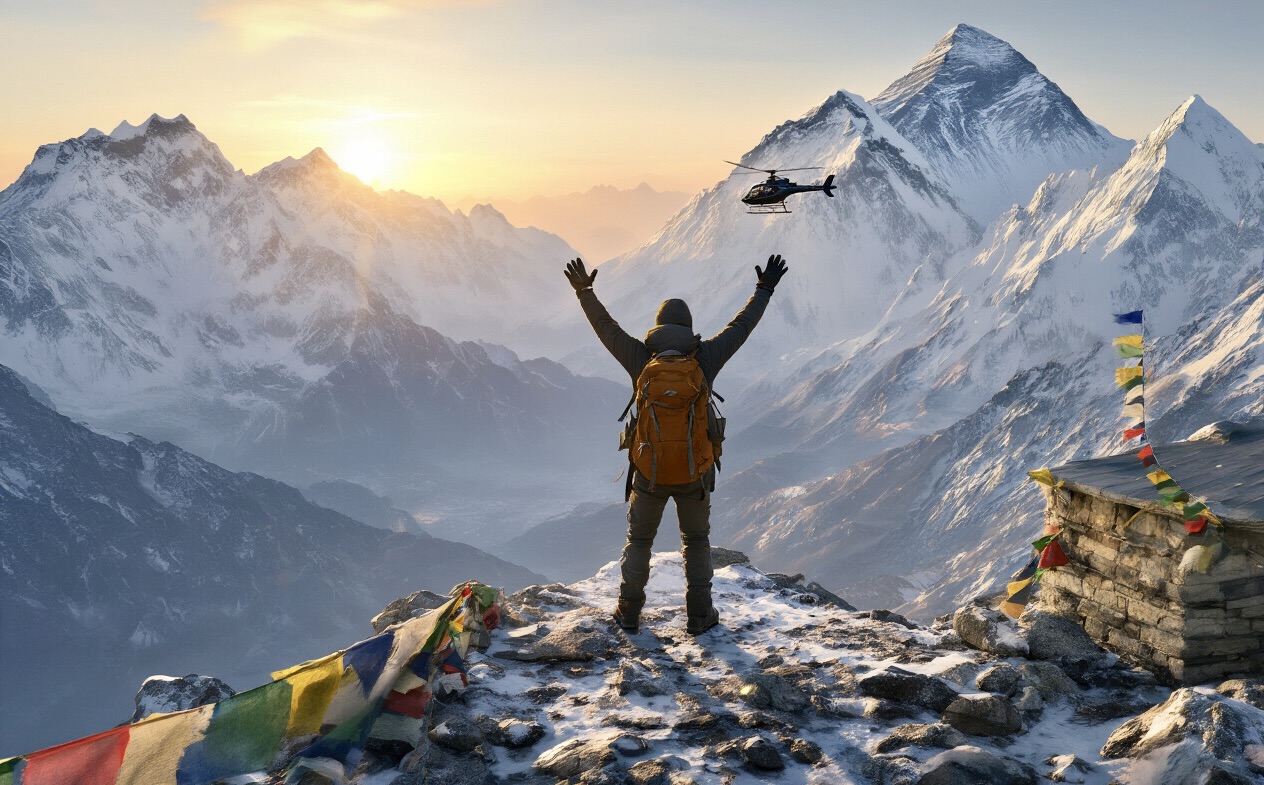
Guide and Porter Qualifications and Support
We employ only the most qualified mountain guides who are certified in Wilderness First Responder (WFR) protocols. Our team members:
- Have extensive experience navigating the Khumbu region's challenging terrain
- Conduct daily health checks using oximeters to detect early signs of Acute Mountain Sickness (AMS)
- Speak English fluently and understand the unique needs of international trekkers
- Maintain 24/7 communication with our monitoring team, tracking your progress
Our porters are not only physically capable but also trained in emergency response procedures, ensuring every member of your trekking team can assist in case of an emergency.
Emergency Response Protocols and Evacuation Procedures
In the Himalayas, helicopter evacuation is often the only feasible method to evacuate a critically ill or injured trekker. Our emergency evacuation process includes:
- An immediate alert system via satellite communication devices that maintain contact even in dead zones
- Pre-arranged coordination with leading air rescue providers and hospitals
- Streamlined documentation process for insurance claims
- Evacuation pickup points at Pheriche, Dingboche, Lobuche, and Gorakshep
When a medical emergency occurs, our guide immediately alerts our emergency coordination team. After assessing the situation and verifying insurance, we trigger the rescue process with helicopters departing from Lukla or Kathmandu, depending on urgency and weather conditions.
Weather-Related Contingency Plans
The Khumbu region is notorious for fast-changing weather conditions. Our contingency plans include:
- Daily weather monitoring and updates from local Sherpa communities and teahouse owners
- Flexible itineraries that can be adjusted based on weather forecasts
- Alternative routes identified in advance to avoid dangerous areas during adverse conditions
- Extra acclimatization days are built into our schedules that can serve as buffer days during weather delays
Our guides are trained to make sound decisions regarding whether to proceed, wait, or retreat based on current and forecasted weather conditions, prioritizing your safety above all else.
Personal Belongings, Security and Recommendations
To ensure the security of your personal belongings during the trek, we recommend:
- Bring essential documents in waterproof pouches (passport, insurance information, permits)
- Use luggage locks for your backpacks and duffel bags
- Keep valuables with you during the day trek
- Store important items and extra cash in inside pockets or money belts
- Consider purchasing travel insurance that covers lost or stolen belongings
During overnight stays at teahouses, we help arrange secure storage for your belongings. Our guides can also assist with safeguarding valuable items throughout the journey.
We maintain strong coordination with local authorities, including TAAN (Trekking Agencies' Association of Nepal), Nepal Police, and Army Units, which enhances the security infrastructure throughout your Everest Base Camp trek experience.
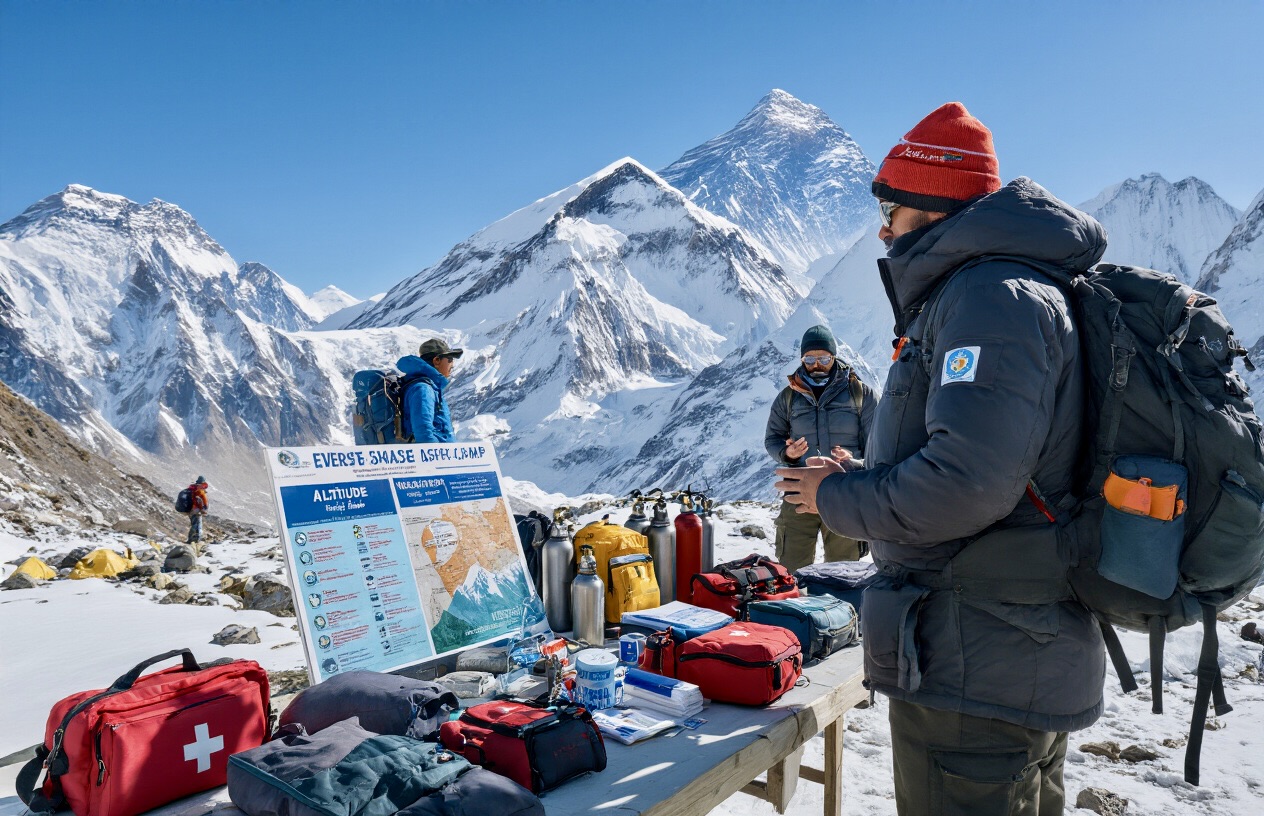
The Everest Base Camp Trek with a helicopter return offers an ideal blend of adventure and convenience for those seeking the ultimate Himalayan experience. From the stunning natural landscapes to the rich Sherpa culture, this journey provides unforgettable memories while the helicopter return option saves valuable time and reduces physical strain. Throughout this guide, we've covered essential preparation tips, accommodation options, logistics, costs, and safety measures to help you plan your expedition with confidence.
As you contemplate this remarkable adventure, remember that proper preparation is key to your enjoyment and success. Whether you're drawn by the challenge of the trek, the majestic mountain views, or the cultural immersion, the EBC Trek with helicopter return represents one of travel's most rewarding experiences. Start planning your journey today, and prepare to stand in the shadow of the world's highest peak for an achievement that will stay with you for a lifetime.
If you need any further information, please contact us by email: at [email protected], Phone: +977 985 100 5129 (WhatsApp)

